Sintra-Portugal.com
The best independent guide to Sintra
Sintra-Portugal.com
The best independent guide to Sintra
Lisbon Airport to Sintra in 2025
Sintra is one of Portugal's most popular destinations, a town known for its enchanting palaces and forested hills. While traditionally seen as a day trip from the capital, Sintra has grown into a holiday destination in its own right, with many visitors choosing to stay for several days to fully explore its wonders.
For travellers flying into Portugal, this means the first part of their holiday is often the journey from Lisbon Airport directly to Sintra. Fortunately, this transfer is straightforward, with several options available to suit different budgets and travel styles.
The journey by public transport, using the metro and train, is inexpensive and reliable, though it takes around 80 minutes. For a faster and more direct transfer, ride-hailing apps (like Uber and Bolt), taxis and pre-booked transfers offer a convenient door-to-door service.
This guide details all of the options for travelling from Lisbon Airport to Sintra. It provides a complete breakdown of the public transport route and offers advice for using taxis and ride-hailing apps.
Insight: This guide details the journey from the airport to Sintra. For the return trip, the directions and information can simply be followed in reverse.
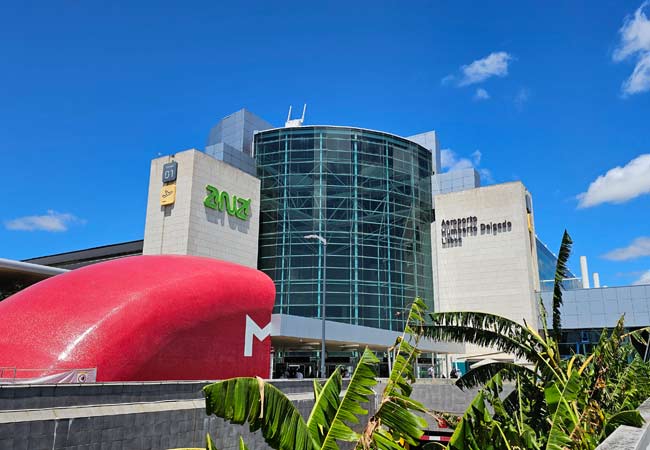
Lisbon Airport and the bright red entrance to the metro.
What are the options for travel from Lisbon airport to Sintra
Sintra lies 25km to the west of Lisbon Airport, and there are four main options for the onward journey:
• Public transport (metro and train)
• Ride-hailing app (Uber or Bolt)
• Pre-booked private transfer
• Taxi
The best choice depends on your budget, time of arrival, group size, and personal preference.
Public transport offers the most economical route. The journey, using the metro and train, costs only €4.25 (€1.80 for the metro, €2.45 for the train) and takes approximately 80 minutes. This is a very effective option for travellers on a budget who arrive during the day and are not in a rush.
A ride-hailing app like Uber or Bolt provides a much faster and more convenient transfer, especially for those with heavy luggage, children, or travelling in a group of up to four. Fares are dynamic and depend on demand, but can start from as low as €25. Be aware that at peak times, prices will be higher, and it can be difficult to connect with a driver. It is advisable to have the app installed and set up on your phone before you arrive in Portugal.
A pre-booked private transfer requires organising in advance but provides the most seamless arrival experience. For a taxi, this will be the most expensive method. Unfortunately, taxis hired directly from the airport have a reputation for exploiting travel-weary tourists and should be considered a last resort.
Warning: Never accept rides from anyone offering transport inside the terminal. These are unlicensed drivers who will inflate an initial low quote upon arrival. The journey is uninsured and can be dangerous. For your safety, always use the official taxi rank located outside the terminal.
The following sections detail each of these transport options, providing all the information needed to choose the best one for your trip.
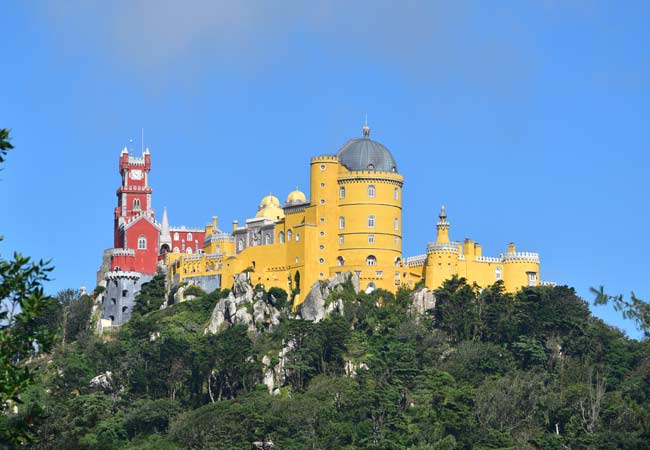
The beautiful Pena Palace
Ride-hailing apps from Lisbon airport to Sintra
For most visitors heading to Sintra, the ride-hailing apps Uber and Bolt are an excellent option. Fares are significantly lower than a conventional taxi, and the exact price is confirmed at the time of booking.
The cost of the journey to Sintra varies depending on demand, but prices can start from as low as €25 for a car with up to four people during a mid-morning pick-up in the low season.
Insight: Uber is typically slightly more expensive than Bolt, but the standard of the cars and drivers is often higher.
The main downside of using these apps is the difficulty in connecting with a driver during peak times, such as rush hour, early evenings, and the high season of July and August. Many drivers may reject an airport pick-up for simpler fares, which can lead to the app continually searching for a driver. In some cases, a driver may accept the fare but drive in the wrong direction in the hope that the passenger will cancel.
A useful strategy for the journey to Sintra is to book a ‘comfort’ level car, which costs approximately 15 per cent more. This ensures a larger, better-quality car, and the higher fare makes the trip more attractive to drivers, increasing the chance of a quick connection.
Insight: Travellers from countries that do not use the Euro should ensure their ride-hailing app is linked to a bank account that does not charge high fees for foreign currency transactions. Fares are charged in Euros, and these additional bank fees can accumulate over a trip.
It is important to remember that you will need mobile internet to book a ride. If you experience any issues, check that your phone's data roaming is enabled or use the free internet in Lisbon airport.
At the airport, Uber and Bolt drivers use a single, designated pick-up location. This is found in the short-stay car park (referred to as P2), situated to the north of the arrivals hall, just past the Starbucks coffee shop.
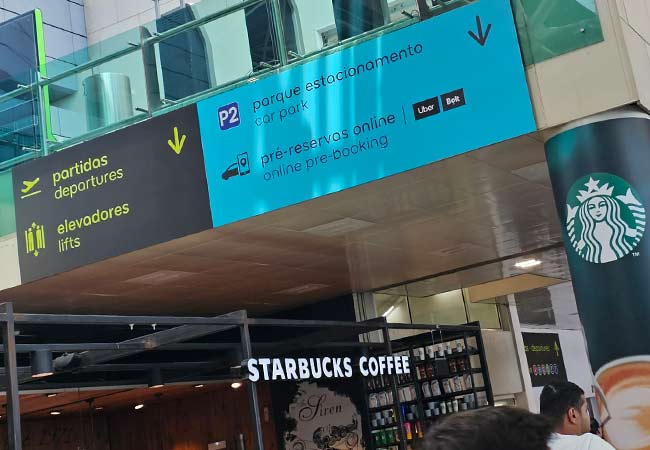
In the airport, follow the ‘Pré-Reservas Online’ signs for the Uber and Bolt pick-up area.
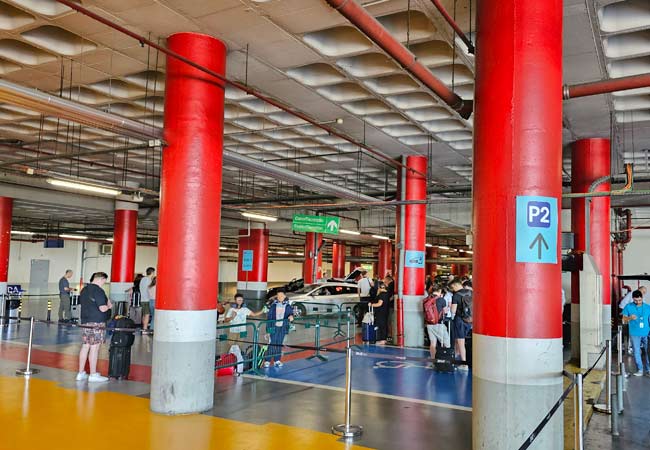
The Uber and Bolt pick-up area is within the short-stay car park.
A pre-booked private transfer to Sintra
A pre-booked private transfer is an extremely convenient option that requires planning before arriving in Lisbon. This service is a hassle-free alternative that will generally cost less than a regular taxi hired from the airport.
Besides being a more cost-effective choice, a key advantage is having a driver waiting for you in the arrivals hall to help navigate the busy airport.
We have worked with GetYourGuide for the last seven years, and some of the best airport transfers they offer include:
A taxi to Sintra
A taxi from the airport to Sintra should be the backup when all the other options are not available, such as when it is too late for the train or Uber/Bolt drivers are not accepting the fare. A taxi hired directly from the rank outside the arrivals hall will be the most expensive way to travel to Sintra.
The exact fare is difficult to predict, as it depends on traffic, the time of day, and the day of the week, with fares being higher on weekends. A typical journey to Sintra will cost around €70, with a 20 per cent surcharge for night-time travel and on weekends. An additional fee of €1.65 for luggage will also be added.
Once a Lisbon taxi leaves the city limits, the fare rate increases, making long-distance journeys costly. Avoid taking a large 7-seater taxi unless necessary, as these have a 20 per cent higher tariff than a standard four-seater car.
If taking a taxi, always insist that the meter is used from the start, or agree on a fixed price before beginning the journey. Unfortunately, Lisbon’s taxi drivers have a reputation for trying to exploit exhausted tourists who have just landed.
Insight: It is always a good idea to have cash available for the fare, in case the taxi's mobile payment machine does not accept your bank card.
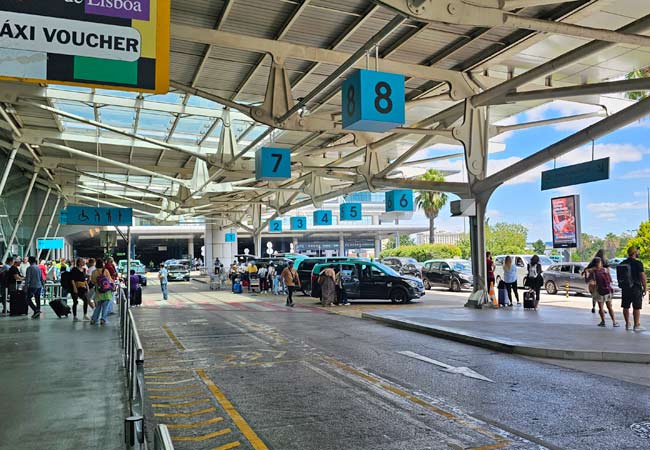
The taxi rank in front of the terminal building.
Airport to Sintra by public transport
Travelling from Lisbon Airport to Sintra by public transport is a straightforward and inexpensive option. The journey involves three distinct stages:
1) Lisbon Airport to Oriente train station: This transfer is most efficiently made using the metro, a short journey of just 7 minutes. Taxis or Uber are alternative options.
2) Oriente station to Sintra station: A direct urban train connects Oriente to Sintra in 47 minutes.
3) Sintra station to your accommodation: The final leg can be completed on foot, or by taking a taxi, Uber or Bolt.
Services on both the metro and train lines are frequent, with multiple departures per hour running from early in the morning until late at night.
The final stage of the journey from Sintra station can be the most challenging. The town is spread across steep hills, and the station is located 1.5km from the historic centre. Depending on your accommodation's location, this could involve a strenuous uphill walk. Taxis are readily available outside the station, and ride-hailing services also operate throughout the area.
Stage 1: Lisbon Airport to Oriente Station
All international arrivals at Lisbon Airport are handled by Terminal 1. The arrivals hall is often busy and compact; upon exiting customs, the metro entrance is just outside and to the right, the official taxi rank is directly in front, and the pick-up area for ride-hailing apps is to the left.
The airport is connected to the city by the red metro line. For the journey to Sintra, you will need to take this metro to the Oriente train station. The journey is very short, covering just three stops in approximately 7 minutes, and is often faster than waiting for an Uber.
A single metro ticket costs €1.80, which is charged to a reusable ‘Navegante’ card. The initial purchase of the card costs €0.50. It is important to note that each traveller in a group must have their own individual Navegante card.
The metro station entrance is located outside the main arrivals lounge and is easily identified by its bright red exterior. While there is a ticket office, it is usually much faster to use the ticket machines. These are user-friendly, with instructions in multiple languages (including English, Spanish, and French), and accept bank cards as well as notes up to €20.
Insight: It is also possible to pay for the metro by tapping a contactless bank card directly on the barrier. This system works well, but each passenger will need their own separate bank card to tap in.
The red metro line is modern, having opened in 2012, and offers full disability access with multiple lifts at both the airport and Oriente station.
Alternatively, a taxi from the airport to Oriente station will cost between €7 and €10, plus a luggage fee.
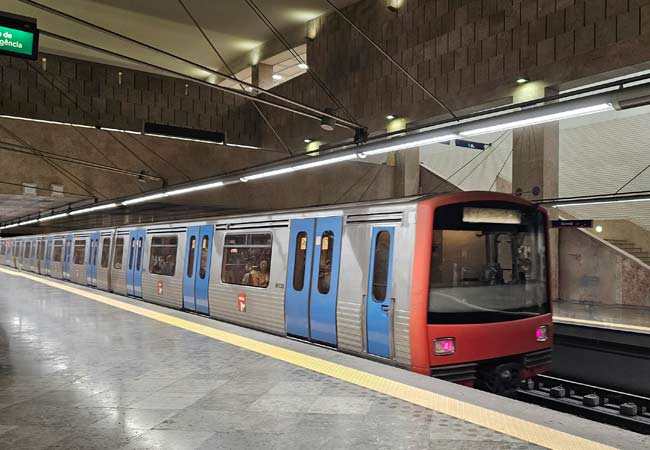
The metro is the best option for onward travel from the airport.
Oriente to Sintra by train
A regular urban train service connects Lisbon to Sintra, departing from Oriente station. This major transport hub is situated in the Parque das Nações district to the northeast of Lisbon, GPS: 38.767, -9.09 (link to Google maps).
The train service is operated by Comboios de Portugal (CP), the national rail company. A single ticket costs €2.45 for an adult and €1.25 for a child, and the fare is charged to the same Navegante card used for the metro. As this is an urban railway, tickets cannot be pre-booked or seats reserved.
The full pricing policy for Lisbon’s urban railway can be seen on the CP website:
www.cp.pt
(The link opens a new PDF tab, which may download on some mobile devices).
The journey to Sintra takes 47 minutes, and the town is the final stop on the line. Services are frequent, with multiple departures per hour continuing late into the night. While trains can get busy during the evening rush hour, a key advantage of departing from Oriente is that it is the first stop, so seats are always available.
For the exact timetable, refer to the CP website:
www.cp.pt
(The link opens a new PDF tab, which may download on some mobile devices).
Oriente is a large, modern transport hub that is generally busy but well-organised with clear signage. The train platforms are on the top level, with the ticket offices situated one level below. Departure platforms are announced on the information screens 15 minutes before the train leaves. While the station is safe, normal precautions should be taken, such as keeping luggage attended and valuables hidden.
The train journey itself passes through the residential suburbs of Lisbon, so there is little of scenic interest along the way. If you have time to spare before your train, the Vasco da Gama shopping centre is located directly opposite the station and has a large food court on its top floor.
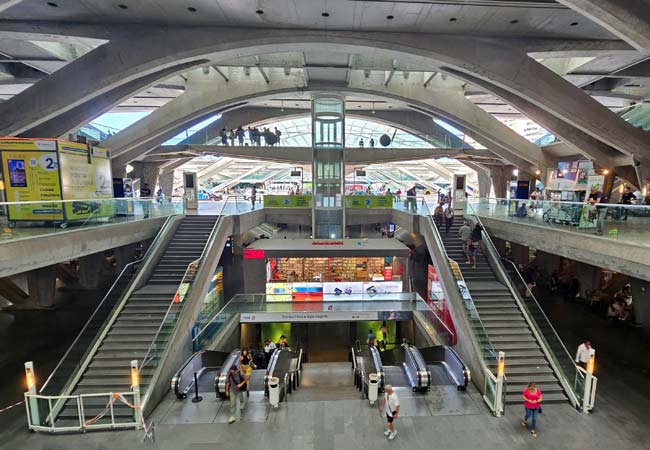
The main concourse of Oriente station, with the metro on the lowest level and the ticket offices and platforms on the upper level.
Rossio Station to Sintra
A secondary train service to Sintra departs from Rossio station (GPS: 38.714, -9.140). This station is not the recommended departure point when travelling from the airport, but it is frequently mentioned in tourist literature because of its central location near the Baixa and Chiado districts.
Reaching Rossio from the airport is less direct than travelling to Oriente. The journey by metro requires taking the red line and then changing to the green line at Alameda station. A taxi fare from the airport will be approximately €15, while an Uber or Bolt will cost around €10.
Due to its popularity with day-trippers, the ticket offices and machines at Rossio can get extremely busy with long queues.
Insight: For any journey that begins at the airport, Oriente is the superior and more convenient station for connecting to Sintra.

The train from Lisbon to Sintra departs from Rossio railway station
Stage 3: From Sintra Station to Your Accommodation
Sintra train station is the final stop on the railway line, located 1.5km from the historic centre (GPS: 38.798, -9.386). From here, travellers must complete the last part of their journey to their accommodation. Taxis are always available from the rank directly outside the station, or it may be a short walk depending on the location.
Insight: Upon exiting the station, it is common to be approached by numerous ticket sellers and tour promoters. It is advisable to proceed directly to your accommodation and make decisions about activities later, once you are settled and not tired from travelling.

Sintra train station
Our most popular guides to Sintra
If you've found our content valuable, we'd welcome your support.
The digital publishing landscape has evolved significantly. As a small independent publisher, we face growing challenges. Search engines increasingly favour paid content over organic results, while AI-generated content often reproduces original work without attribution.
To support our work, please consider bookmarking this page (press Ctrl + D) for quick access. If you find an article helpful, we'd be grateful if you'd share it with friends on social media.
For specific questions, please see our Reddit community at r/LisbonPortugalTravel.
Should you notice any outdated or incorrect information, please contact us at [email protected]
Thank you for helping us continue to provide valuable content in an increasingly challenging digital environment.
A complete list of all of our Sintra and Lisbon guides
If you've found our content valuable, we'd welcome your support.
The digital publishing landscape has evolved significantly. As a small independent publisher, we face growing challenges. Search engines increasingly favour paid content over organic results, while AI-generated content often reproduces original work without attribution.
To support our work, please consider bookmarking this page (press Ctrl + D) for quick access. If you find an article helpful, we'd be grateful if you'd share it with friends on social media.
For specific questions, please see our Reddit community at r/LisbonPortugalTravel.
Should you notice any outdated or incorrect information, please contact us at [email protected]
Thank you for helping us continue to provide valuable content in an increasingly challenging digital environment.





























